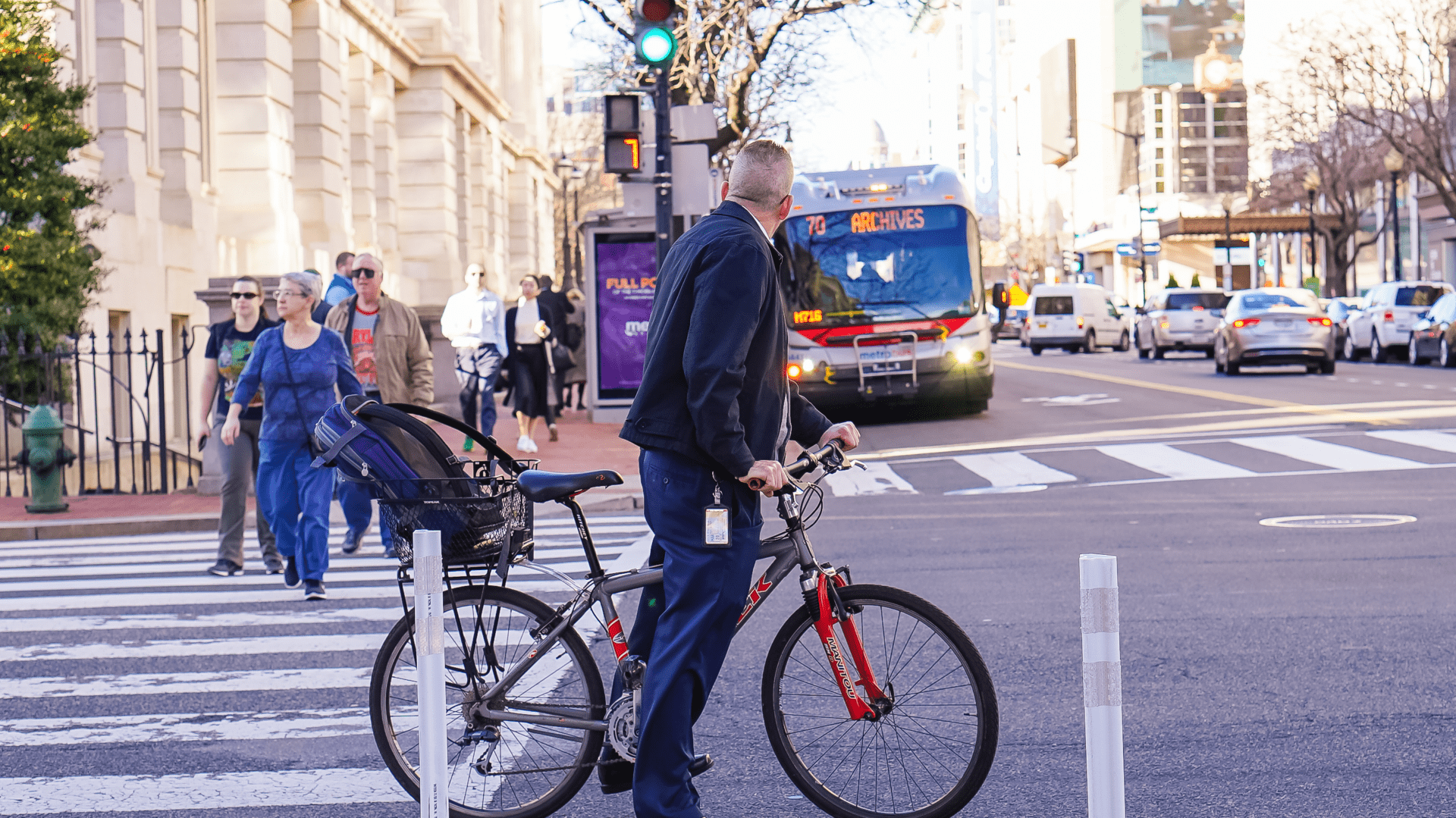October 8, 2024
Improving safety for everyone—whether you get around by walking, biking, rolling, or driving—is a foundational priority in the transportation industry. Unfortunately, it’s also easier said than done: our roadway network is so vast, and maintained by so many different actors, that planning and implementing a coherent and consistent strategy for roadway safety can feel like playing a game of telephone, with the message gradually breaking down throughout the life of its transmission.
Local Road Safety Plans (LRSPs) provide a roadmap for a future transportation system—roads and people—that address local issues and provide for the safety of a community’s residents and visitors. As the name suggests, these plans target local roads and are typically crafted at a local level, with a city or town generating a list of recommendations and a path to implement them. Sometimes, however, an agency with a wider purview may choose to bring most or all of its constituent local agencies (the cities or towns contained within it) together to collaborate on and agree to a combined LRSP. That combined LRSP may result in a single countywide document that describes the conditions and the vision for safety at a county level. Or, better yet, it may do all that and provide locally tailored plans based on those countywide findings.
What are the benefits of creating a safety plan at this larger scale? And as if developing an LRSP for one agency wasn’t challenge enough: do those benefits outweigh the coordination and complexity of assembling an LRSP on behalf of many local agencies?
Earlier this year, we helped to develop a countywide plan on behalf of the San Mateo City/County Association of Governments (C/CAG), which plans and coordinates among the 21 local agencies in San Mateo County in California’s Bay Area. Below are our tips to maximize the benefits of tackling safety from a wider scope, while still keeping unique city needs front and center.

Road users need consistency regardless of jurisdiction to navigate roads as safely as possible. When safety measures are planned collaboratively, the resulting projects can create that consistency, giving road users reliable expectations they can get used to.
But Wait—What Happened to “Context-Specific” Planning?
Perhaps safety planning at the larger scale of C/CAG seems like bad meteorology, a plea to coordinate safety at a macro level at a time when industry winds are increasingly blowing toward hyper-localized, context-specific safety planning. We ourselves have written extensively on how vital it is for engineers and planners to consider local context and prioritize performance-based design, which foregrounds local context and community priorities to make geometric design decisions.
At the same time, there are real safety benefits to taking a macro, cross-jurisdiction approach to planning, as well. Here are some reasons why a greater coordination between localities can be essential to achieving safety:
- Countywide plans can uplift cities that might otherwise fall through the cracks. The plan positions the agencies for funding, enabling them to meet regional, state, and federal requirements for future grant opportunities. In the absence of a coordinated plan, some of the local cities may not have the bandwidth to locate resources and do the formal planning work necessary on their own. But the C/CAG plan renders all jurisdictions who adopt it eligible for grants. Finally, when part of a multijurisdictional effort, agencies can lend one another support through data sharing, local knowledge, coordination, or letters of support—all of which strengthens a case for funding.
Additionally, the scale of a C/CAG’s plan provides qualitative benefits to plans, allowing a larger effort on data collection, analysis, and synthesis—resulting in a more robust plan than may otherwise be realized at the local level. For example, In San Mateo County, just 11 of 21 constituent cities had done their own safety plan, and the remaining 10 either had no safety plan or needed an update.
- Countywide plans are not only to the benefit of smaller cities, but to road users. Many major arterial roadways pass through multiple cities. These roadways naturally carry lots of traffic and tend to rank highly on prioritized lists. Forty-three percent of all fatal and injury crashes in San Mateo County occurred on a State highway, and the number of roads that continue from city to city goes far beyond highways. El Camino Real, for example, is in the C/CAG High Injury Network (HIN) and it runs through 12 jurisdictions—touching over half of those in San Mateo County.
If cities don’t coordinate their efforts, the resulting vision may won’t be consistent along a road. Road users need consistency regardless of jurisdiction to navigate roads as safely as possible. When safety measures are planned collaboratively, the resulting projects can create that consistency, giving road users reliable expectations they can get used to. Reviewing road safety across C/CAG’s jurisdiction can provide more comprehensive information that can better inform safety measures.
- Countywide plans are better suited for interdisciplinary collaboration, like looping in law enforcement, public health, and community organizations. While all LRSPs incorporate public outreach and community engagement, coordinating efforts at C/CAG’s level can help to cast a wider net of involvement. The C/CAG plan identifies critical partner organizations, like the California Highway Patrol, Caltrans, Bay Area Rapid Transit (BART), San Mateo County Sustainability Department, and San Mateo County Health. Such collaborations allow the plan to tackle related challenges, like conservation and air quality, with its road safety projects. This promotes efficient, interconnected change.

Countywide collaboration should not come at the cost of the aforementioned context-specific individualization.
So, Is Bigger Always Better?
Certainly not. While we’ve spelled out a few real advantages to working at a larger scale above, this level of synchrony is not an automatic solution to roadway safety. It takes far more intensive communication and collaboration to balance the needs and wishes of many agencies rather than one. For the C/CAG plan, we were able to streamline this process of communication by helping C/CAG be the contact point for all 21 localities involved in the planning process—much simpler than having them all coordinate with one another.
Still, coordination hurdles existed. Eleven of San Mateo’s localities did not have a chapter included in the C/CAG plan, either because they already have a citywide safety plan or are in the process of developing one. Nevertheless, it’s incumbent on the coordinating agency to still include these localities in the county-level discussions to make sure their priorities and planning are reflected in the C/CAG LRSP.
It’s also important to emphasize that countywide collaboration should not come at the cost of the aforementioned context-specific individualization. The C/CAG plan begins with the countywide LRSP and is followed by 10 chapters of locality-specific LRSPs. Each chapter includes comments from residents of the city, bringing on-the-ground advocacy into action. Additionally, these individual chapters contain bespoke prioritized locations and action plans tailored to each community’s safety gaps. Combining overarching, more general guidance with context-specific recommendations can keep unique needs from getting overlooked while still contributing to a unified effort.

Although LRSPs are an essential step to set a region up for success, their real value comes in the long term. We’re seeing this future-oriented growth come in as C/CAG phases out of plan development and into action on the roads.
A Plan Is Only as Good as Its Implementation
The C/CAG board adopted the final countywide LRSP in June 2024. Among its many recommendations, the plan suggests evolving its working group into a countywide Transportation Safety Advisory Committee (TSAC) and tasking it with implementing the plan and tracking progress. Dedicating a committee to implementation will help agency staff focus on and prioritize the recommendations put forth in the plan. The formation of TSAC offers one more important reminder from our time working on this plan for C/CAG: although LRSPs are an essential step to set a region up for success, but their real value comes in the long term. We’re seeing this future-oriented growth come in as C/CAG phases out of plan development and into action on the roads.
